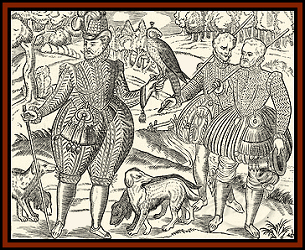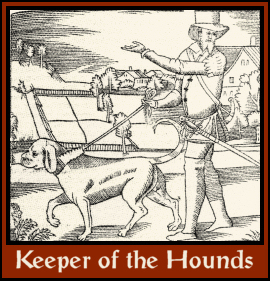A Cry of Hounds

Immediately after supper, the huntsman should go to his master's chamber...to know his pleasure in what quarter he determineth to hunt that he may know his own quarter. That done, he may go to bed, to the end he may rise the earlier in the morning....
Poachers and gamekeepers trap animals with nets and traps, but this is not sport. A gentleman hunts with his hawk or his hounds.
Hunting the fox is not yet an aristocratic activity, being essentially a form of pest control. Farmers use their dogs to chase down foxes who are pestering their livestock, however fox hunting with all its formalities and traditions does not yet exist.
The dogs
Gentlemen use their hounds to track, corner, and occasionally kill deer—especially the hart or stag—and boar, hare, and occasionally bear and wolf, especially if they are threatening the other game.
The use of running hounds to track prey dates back to ancient times; the Romans brought their dogs to Britain in the 1st century, where the Britons were already hunting with Agassaei hounds.
Sight hounds, (sometimes called gazehounds) including greyhounds and Irish wolfhounds, are prized for visual acuity and speed, crucial when coursing, in which the prey is sighted, stalked silently, pursued, and taken down. These dogs are also known for their ability to stalk in silence.

Many sight hounds are of somewhat fragile build, but can be improved with crossbreeding. When you mix a sighthound with a sturdier working dog, the result is a lurcher.
Scent hounds are valued for their sense of smell. They are generally used in a pack, known as a cry of hounds. Some breeds, such as beagles, have a bell-like bark or yell; others are known for deep, booming barks.
Turberville tells us that the huntsman should first "take a little vinegar in the palm of his hand and put it in the nostrils of his hound, for to make him snuff, to the end his scent may be the perfecter."
A lymer is a specially trained scent hound, such as a Bloodhound or a St Hubert's. When hunting deer, the huntsman takes him out in the field early in the day (the quest) to locate droppings (fewmets) or tracks of a deer and, with luck, find where the animal is browsing or resting, without scaring it away. This is known as harbouring the prey.
Several lymers and their keepers may be sent in different directions of a morning, to save everyone time when the hunt is ready to begin.
Gervase Markham suggests tuning your cry of hounds to make a more pleasant music:
If you would have your kennel for sweetness of cry, you must compound it of some large dogs that have deep solemn mouths, and are swift in spending, which must as it were bear the base of the consort. Then a double number of roaring and loud ringing mouths which must bear the counter tenor. Then some hollow, plain sweet mouths, which must bear the mean or middle part. ... Amongst these you may cast in a couple or two of small, single beagles, which as small trebles may warble amongst them. The cry will be a deal more sweet.
The Hunt
The Tudor hunt is in transition from the high medieval form.
All aspects of the hunt, each part of every animal, every behavior of hound or hunter has a name, originally derived from Norman French. The old terms are still in use but many are already being replaced by good, sturdy English.
We believe that our hunting terms and practices date back to the time of King Arthur, even if they are a bit out of date. Anyone for whom hunting is a passion knows all these things by heart.
A proper deer hunt with dogs is called par force or par force de chiens (by strength).
In a hunt by bow and stable, deer are herded into a prepared enclosure and shot by archers from a platform. This is less sporting, and certainly less noble, but more efficient when putting meat on the table is the principal aim.
The hunter's weapon when stalking any sort of deer is the sword. The sword is usually employed in the hunt par force, the bow in the hunt by bow and stable.
Boar are killed with a boar spear, ideally from horseback but occasionally on foot. The boar spear is a long, sturdy weapon with a cross piece below the blade to keep the animal from running up the shaft.
The great prize of any hunt is the buck (a male fallow deer) or stag (a male red deer). The impressiveness of the prize is determined by the number of points on the antlers. A lean and scrawny specimen is called a rascal, and is of no interest.
This most noble form of venery, the hunt par force, has eight formal stages: the quest, the assembly, the relays, the moving or un-harboring, the chase, the baying, the unmaking, and the curée.

When the lymers and huntsmen return from the quest, they probably find the host and his guests breakfasting—servants, good silver, and all (the assembly). The company listen to the report, examine any droppings, and decide how to proceed.
Turberville advises that "if [the huntsman] chance by the way to find any hare, or partridge, or any other beast that is fearful, living upon seeds or pasturage, it is an evil sign or presage that he shall have but evil pastime that day. But if he find any beast of ravine, living upon prey, as wolf, fox, raven, and such like, that is a token of good luck."
Once the path of the hunt has been determined, relays of dogs are positioned along the way, so that fresh dogs can easily be brought up if the leaders tire.
The call goes out: "The hunt is up!" And the chase is on. When the deer is roused from cover, it is said to be unharboured.
The baying occurs when the prey can run no further, either from exhaustion or because he is trapped, and turns at bay to fight. At this very dangerous stage, the hounds must be held from trying to take the animal down themselves.
Hounds who get ahead of the pack are guilty of over-topping, and require further training.
The host or his most prominent guest has the privilege of dismounting and actually killing the animal. At its death (the mort) the huntsmen sound a note on their hunting horns signaling all the participants that the chase has ended. This is called blowing the mort.
As soon as the beast is dead, the men lay it on its back and some gentleman performs the assay, in which the quality of the flesh is tested by drawing a knife along the "brisket of the deer, somewhat lower than the brisket towards the belly". Everyone examines and discusses the results.
This proceeds to the unmaking, a highly ritualized process of dissecting the carcass and distributing or packing up the parts. This, like the assay, is a task performed by a gentleman or a person of rank. The ritual is too important to leave in the hands of common men.
The final ritual is the curée, when all the dogs are rewarded with bits of flesh. The lymers, who were not at the chase but located the prey to begin with, get the first tidbits.
All the participants in the death may be marked with a dab of the deer's blood, and the hunt us over. The rest of the day may be spent in the usual festive country merry making.
Sources:
Guild of St George handouts created by Kathy Lear, Shelley Monson, Aurie Bradley, mid-1980s.
George Turberville, The Noble Art of Venerie
Gervase Markham, Country Contentments
![]() The Hunt is Up
The Hunt is Up
![]() Now Merrily to Horse
Now Merrily to Horse
![]() Filling the Time
Filling the Time
![]() Games
Games
![]() More Things To Do
More Things To Do
![]() Still More Things To Do
Still More Things To Do





13 March 2010 mps
